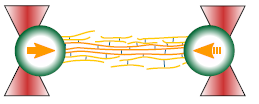P6: Generation of Directed Motion: Hot Random Steps in Cytoskeletal Systems Can Lead to Processive Movement
 Intracellular transport comes in a wide variety: from the purely diffusive, random motion of components immersed in the cytosol to the highly directed, deterministic translocation of molecular motors. The latter may even perform multiple steps in a row, an ability referred to as processivity. It is the wide spectrum between random and highly processive motion that we will investigate here. While most motor proteins are rigidly bound to their cargo, some of them are only loosely attached. For example, during cell division the relative sliding of microtubules against each other is facilitated by diffusively anchored kinesin motors. What forces are generated during this process and what are the benefits of such diffusive anchorage, similar to a ‘lowered’ processivity? On the other hand, the processivity of cytoskeletal actuation can also be increased: the protein formin enhances the polymerization-driven, thermal-ratchet-like forward motion of actin filaments. How do step size and force during polymerization compare to the case without formin? And, can the rather random and truly non-processive depolymerization of actin filaments in a small actin bundle generate a sufficient entropic change to contract the assembly along the bundle axis? Using single-molecule techniques applied to reconstituted in vitro assays, we will characterize (i) the microtubulemicrotubule sliding actuated by diffusively anchored kinesin-14 motors, (ii) the polymerization of actin filaments in the presence of formin, and (iii) the contraction of actin bundles induced by filament depolymerization. We regard these processes as prototypical systems for the intracellular interplay between random, diffusive elements and directed, deterministic constituents. The results of the project are expected to add to our (bio)physical understanding of how biological systems utilize different modes of movement as well as how these modes can be beneficially combined and interconverted.
Intracellular transport comes in a wide variety: from the purely diffusive, random motion of components immersed in the cytosol to the highly directed, deterministic translocation of molecular motors. The latter may even perform multiple steps in a row, an ability referred to as processivity. It is the wide spectrum between random and highly processive motion that we will investigate here. While most motor proteins are rigidly bound to their cargo, some of them are only loosely attached. For example, during cell division the relative sliding of microtubules against each other is facilitated by diffusively anchored kinesin motors. What forces are generated during this process and what are the benefits of such diffusive anchorage, similar to a ‘lowered’ processivity? On the other hand, the processivity of cytoskeletal actuation can also be increased: the protein formin enhances the polymerization-driven, thermal-ratchet-like forward motion of actin filaments. How do step size and force during polymerization compare to the case without formin? And, can the rather random and truly non-processive depolymerization of actin filaments in a small actin bundle generate a sufficient entropic change to contract the assembly along the bundle axis? Using single-molecule techniques applied to reconstituted in vitro assays, we will characterize (i) the microtubulemicrotubule sliding actuated by diffusively anchored kinesin-14 motors, (ii) the polymerization of actin filaments in the presence of formin, and (iii) the contraction of actin bundles induced by filament depolymerization. We regard these processes as prototypical systems for the intracellular interplay between random, diffusive elements and directed, deterministic constituents. The results of the project are expected to add to our (bio)physical understanding of how biological systems utilize different modes of movement as well as how these modes can be beneficially combined and interconverted.
Project Leaders
Prof. Stefan Diez
TU Dresden
B CUBE/BioNanoTools
